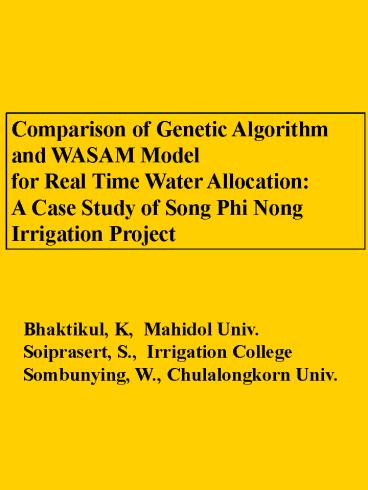Comparison of Genetic Algorithm and WASAM Model - PowerPoint PPT Presentation
1 / 40
Title:
Comparison of Genetic Algorithm and WASAM Model
Description:
Genetic Algorithms in search optimisation&machine learning. ... Optimisation Approaches. linear Programming. dynamic programming (DP) ... – PowerPoint PPT presentation
Number of Views:61
Avg rating:3.0/5.0
Title: Comparison of Genetic Algorithm and WASAM Model
1
Comparison of Genetic Algorithm and WASAM Model
for Real Time Water Allocation A Case Study of
Song Phi Nong Irrigation Project
Bhaktikul, K, Mahidol Univ. Soiprasert, S.,
Irrigation College Sombunying, W., Chulalongkorn
Univ.
2
References
- Davis,L. (1991). Handbook of Genetic Algorithms.
Van Nostrand Renhold, New York. - Goldberg, D.E.(1989). Genetic Algorithms in
search optimisationmachine learning.
Addison-Wesley Publishing Company Inc,USA. - Michalewicz, Z. (1992). Genetic algorithms data
structures evolution programs. Springer-Verlag,
New York, Inc., New York. - Wardlaw, R.B., and Sharif, M. (1999). Evaluation
of genetic algorithms for optimal reservoir
system operation. J. Water Resour. Plng. and
Mgmt., ASCE 125(1), 25-33.
3
Presentation Outline
- What is GA and Why GA?
- Application to the water allocation test system
- Application to an irrigation system in
- Conclusion
4
Optimisation Approaches
- linear Programming
- dynamic programming (DP)
- non-linear programming (quadratic, QP)
- simulated annealing (SA)
- evolutionary algorithms (genetic algorithms, GAs)
- artificial neural networks (ANNs)
5
Comparison of Natural and GA
- chromosome string
- gene feature, character
- allele feature value
- locus string position
- genotype structure
- phenotype alternative solution
- epistasis nonlinearity
6
The Water Allocation Problem
- To ensure the equitable distribution of water
supplies within an irrigation system. - It is not a planning problem in the crops are
assumed to be in the ground. - It is not a scheduling problem in that irrigation
supplies are assumed to be run of river.
7
Objective of The Study
- To determine optimal and equitable water
allocation in various water supply situations
(deficit, normal, surplus) using GA. - Study Area
- Song Phi Nong Irrigation Project which covers
area of 300,000 rai and 32 irrigation schemes
8
Why GA ?
- GA is flexible and easily set up for
- a wide range of linear and non-linear objective
functions. - GA is an alternative approach.
9
How the GAs work?
- work with a coding of parameter set
- search from a population of points
- use objective function information
- use probabilistic transition rules,
Goldberg (1989).
10
A Simple Test System
11
An Example of a Chromosome Represents the
Flows(qi) in Each Canal
12
GA process
1.Initialize a population of chromosome. 2.Evalua
te each chromosome in the population. 3.Create
new chromosomes by mating current chromosome
apply mutation and recombination as the parent
chromosomes mate. 4.Delete members of the
population to make room for the new
chromosomes. 5.Evaluate the new chromosomes and
insert them into the population. 6. Stop and
return the best chromosome if time is up
otherwise go to 3. Davis(1991).
13
Three Operators of Genetic Algorithm
Selection Operator
string are selected for inclusion in the
reproduction process
-
Crossover Operator
- permits the exchange of genes between pairs
of chromosomes in a population
Mutation Operator
- permits new genetic material to be
introduced to a population
14
Probability of Selection (Pi)
- fi fitness of individual chromosome in that
generation - n population size
15
One Point Crossover
- Approaches to crossover (after Wardlaw and
Sharif, 1999)
16
Two Point Crossover
17
Uniform Crossover
18
Mutation Schemes
- In binary coding, individual of alleles changed
from 0 to 1 or vice versa. - Uniform mutation, the value of a gene can be
mutated randomly within its feasible range of
values. - Modified uniform mutation permits modifications
of a gene by a specified amount - Non-uniform mutation, gene can be mutated by the
reduced amount as the run progresses.
19
Nodal Water Balance
20
A Simple System
21
Objective Function
After Wardlaw and Barnes, 1996
22
Constraints
- i) Capacity constraint Qij lt qmaxij
- ii) nodal balance constraint
- iii ) supply constraint
xi lt di
23
- where
- Q(N) flow in reach N
- S(N) water requirement within reach N
- Q(I) discharge from reach N to connecting
reach I til reach M - LOSS(N) Loss in canal within reach N
24
Penalty Function 1
25
Penalty Function 2
26
Penalty Function 3
27
Schematic Diagram of Song Phi Nong Irrigation
System
28
Song Phi Nong Irrigation System
- Seasonal water requirement is in range 0.0 5.65
m3/s - Max. canal capacity 0.42 82.98 m3/s
29
Schematic Diagram
30
(No Transcript)
31
Water Requirement Cases using WASAM
32
GA result when inflow to the system 60
33
GA result when inflow to the system 70
34
GA run result when inflow to the system 120
35
GA run result when inflow to the system 150
36
(No Transcript)
37
(No Transcript)
38
(No Transcript)
39
Best fitness obtained when using Pc 0.7, Pm
0.1, R1 10, R2 4
40
Conclusions
- The advantage of GA is that it could solve the
problem with any type of objective function and
could be easily set up. - In water allocation problem the appropriate
decision variables are the flows that vary as
max. and min.capacity of the canals. - GA has been improved to water allocation problem
if the violation of nodal balance constraints
decreased. - In the deficit case GA can provide an equitable
allocation among nodes while WASAM couldnt. - GA is able to solve the water allocation problem,
reach the optimum and achieves near equity.

